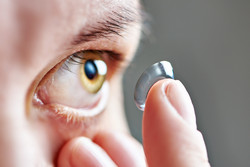Therapeutic contact lenses
The bioavailability of most topical ophthalmic medications is surprisingly limited. The major obstacle to targeting the eye with therapeutics is the presence of various barriers such as the epithelium and the dynamics of eye tissue, which control the concentration and entry of solutes into the eye. These barriers impede the effective passage of many drugs and lead to minimal dose absorption. To address the reduced penetration and efficacy of topically applied molecules, most medications contain an increased dose of the active ingredient. However, this often leads to toxicity, necessitating the development of more effective methods of drug delivery. A good solution for chronic ocular conditions is the use of contact lenses that allow for controlled-release of the impregnated drugs. The EU-funded THERALENS (Biomimetic therapeutic hydrogel layers for interaction with corneal tissues) project set out to advance existing technologies for attaching drugs to contact lenses by avoiding the use of toxic chemicals. For this purpose, they utilised novel biomimetic nanoparticles based on the phospholipid DMPC that could be embedded with the lens. The novelty of these nanoparticles lies in their chemical reactivity: on the inside they could interact with hydrophobic drugs while they retain their water solubility on the outside, in addition, the phospholipid is already present in the natural environment of the eye. During THERALENS, scientists tested a number of active molecules with different hydrophilicities for their capacity to interact with the lens and to achieve controlled release. They extensively optimised the coating strategy of these nanoparticles onto the contact lens. This led to an overall surface improvement and enabled hydrophilic and hydrophobic ophthalmic drugs and phospholipid supplements to penetrate the tear film. The THERALENS system of ocular drug delivery received great interest from the pharmaceutical industry and resulted in a patent application. Commercial exploitation of this technology could increase the efficacy of ophthalmic medications with fewer cytotoxic side effects.







